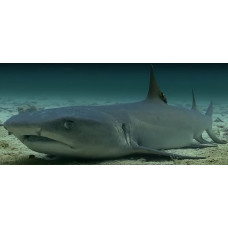Latin name
Carcharhinus longimanus
Other names
Carcharhinus longimanus
Identification
The pectoral fins are considerably longer and wider than those of most other sharks and are distinctly rounded. The snout is rounded and the eyes are equipped with flashing membranes. The body is elongated and streamlined. The triangular lower teeth are relatively small and have a finely serrated tip. The lower jaw has 13-15 rows of teeth on either side of the symphysis. The upper teeth are also triangular, larger and wider than the lower teeth, and their edges are serrated. The upper jaw has 14-15 rows of teeth on either side of the symphysis. The skin is covered with flat placoid scales, each with 5-7 ridges. As well as hearing, these sharks can also smell, which helps them locate prey quickly.
Fish colouring
The colouration of the dorsal surface of the body can be bronze, brown, bluish or grey, the belly is white, sometimes with a yellow tinge. The ends of the fins are covered with white spots. Between the first and second dorsal fins there is a pale saddle-shaped patch in some individuals. The colouration changes significantly with age: from birth until they reach about 1.2 m in length, the spots on their fins are not white, as in adults, but black.
Distribution
They inhabit tropical and subtropical waters of all oceans. They are distributed worldwide from 45° north latitude to 43° south latitude.
Habitat
They are found at depths of up to 230 m. This species is considered to be the most abundant and thermophilic, living in the surface layers of the open ocean at temperatures above 18°C. Their preferred temperature range is between 20°C and 28°C, and when the water temperature exceeds these limits they tend to leave the area. They spend most of their time in the upper ocean at depths of up to 150 metres and prefer to stay away from the coast. Sometimes, however, sharks will come close to shore and swim into shallow water. They are usually solitary, although they may gather in packs in areas where food is plentiful. This species has no diurnal cycle and is active both day and night. Sharks swim slowly with their pectoral fins outstretched.
Size
Reaches 3.5 to 4 metres in length, but more commonly individuals up to 1.5 to 2 metres in length and 20-60 kilograms in weight. The maximum mass recorded is 170 kilograms. Females tend to be larger than males, with males averaging 1.8 metres and females 1.9 metres.
Behavior
They often accompany ships. Sharks that follow ships in the open ocean are usually found with only galley waste in their stomachs. When they approach something that appears to be edible, their movements become more energetic, they continue their pursuit tenaciously, keeping a safe distance and ready to strike at the first opportunity.
When prey is available, they often form packs and go into a feeding frenzy, a state in which they frantically tear at any moving object, including each other, with their teeth. They're very survivable themselves.
In the wild, the shark lives for 15 years, with a maximum lifespan of 22 years.
Food and feeding habits
Oceanic whitetip shark feed primarily on bony fish such as lancetfish, oarfish, barracuda, jacks, mahi-mahi, marlin, tuna, mackerel, as well as cephalopod molluscsrays, sea turtles, birds, snails, crustaceans and mammal carcasses. When hunting, sharks swim through a school of fish with their mouths open, become very aggressive.
Reproduction
In the northwestern Atlantic and southwestern Indian Oceans, the mating season begins in early summer; in the Pacific, pregnant females are caught throughout the year. Like other members of the genus, they are viviparous; developing embryos are nourished by a placental connection to the mother formed by an empty yolk sac. Pregnancy lasts one year. There are 1 to 15 newborns in a litter of about 0.6 m in length. Males and females reach sexual maturity at lengths of 1.7-1.9 m and 1.8-2 m respectively.
Fishing
They are subject to industrial fishing. The fins, meat, skin and liver fat are used.
Relationship with a person
Some of the most dangerous sharks. They pose a minimal threat to beach bathers, but are very dangerous to humans in the open ocean.
| Classification | |
| Phylum | Chordata |
| Class | Chondrichthyes |
| Squad | Carcharhiniformes |
| Family | Carcharhinidae |
| Genus | Carcharhinus |
| Species | C. longimanus |
| Features | |
| Conservation status | Critically Endangered |
| Habitat | Pelagic |
| Life span, years | 22 |
| Maximum body weight, kg | 170 |
| Maximum length, cm | 400 |
| Sailing speed, m/s | No information |
| Threat to people | Edible |
| Way of eating | Predator |
Oceanic whitetip shark
Tags: oceanic whitetip shark


